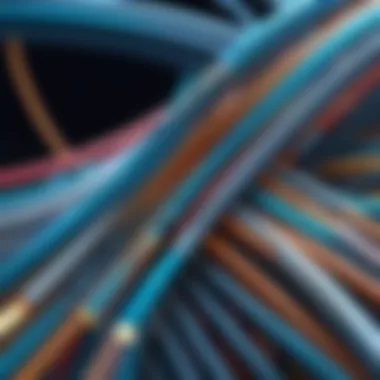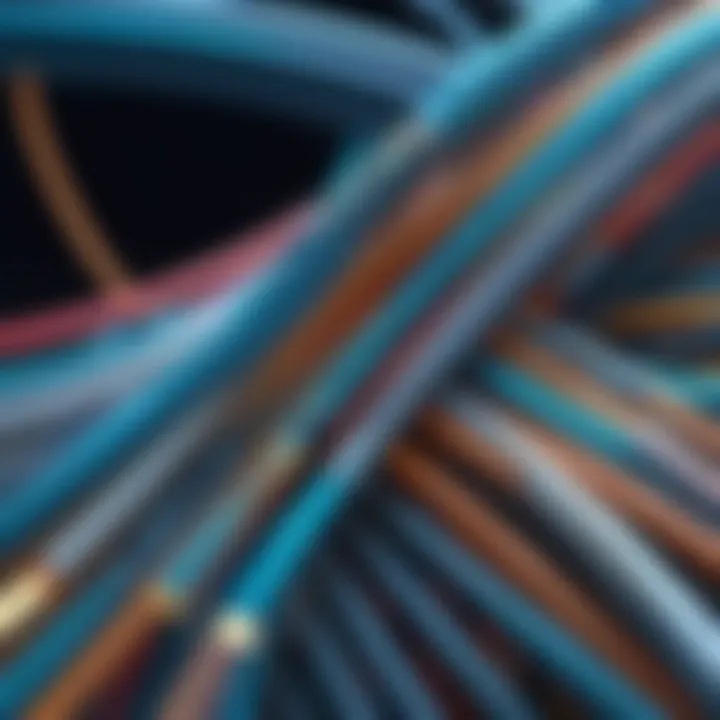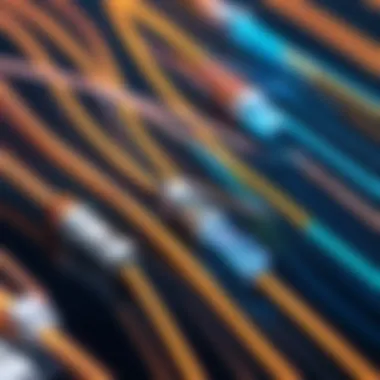Understanding Fibre Optic Technology: Key Insights


Overview of Topic
Fibre optic technology serves as a cornerstone in today’s vast telecommunications landscape. In simple terms, it uses thin strands of glass or plastic to transmit data as light signals, making it exceptionally faster than traditional copper cables. As the demand for high-speed internet and efficient data transfer continues to grow, the significance of fibre optics cannot be overstated.
Historically, fibre optic technology dates back to the early 19th century, but it gained substantial traction in the 1970s when the first commercial systems came into play. Now, it’s not uncommon to see a wide assortment of applications powered by this technology—from internet connectivity to advanced medical imaging.
Fundamentals Explained
The core principles of fibre optics revolve around the concept of total internal reflection. In essence, when light travels through the fibre at a particular angle, it reflects off the internal walls rather than passing through, allowing the light to transmit efficiently over long distances. Key terminology includes:
- Core: The central part of the fibre where light travels.
- Cladding: The outer optical material surrounding the core, which reflects the light back into the core.
- Fibre Types: There are mainly two types—single-mode, which allows one light pathway for long distances, and multi-mode, which allows multiple pathways and is useful for shorter distances.
Understanding these basic concepts lays the groundwork for anyone looking to delve deeper into fibre optic technology.
Practical Applications and Examples
Fibre optics permeate various sectors, proving invaluable for several practical uses:
- Telecommunications: The backbone of global internet infrastructure.
- Healthcare: Utilized in medical instruments like endoscopes, enabling doctors to see inside the human body without invasive surgery.
- Military Applications: Ensures reliable and secure communications in challenging conditions.
Take for instance a case study that focuses on a university upgrading its network infrastructure. By shifting from copper wiring to fibre optics, it solved latency issues, eased bandwidth shortages, and fostered a direct pathway to research that required access to large datasets swiftly.
"The speed of light is not just a measure—it's a revolution in data transmission."
Advanced Topics and Latest Trends
As technology evolves, so does fibre optics. Cutting-edge developments include:
- Fibre Laser Technology: Utilized in various applications, from high-precision manufacturing to defense systems.
- Bend-Insensitive Fibre: Allows more flexible installations without signal loss, catering to modern building designs.
- Photonic Crystal Fibres: Represent a significant leap toward even higher data transmission capabilities.
Looking to the future, we can expect innovations in fibre optic sensor technology, enabling more accurate measurements in industries like aerospace and environmental monitoring.
Tips and Resources for Further Learning
For students or IT professionals keen on expanding their knowledge in fibre optics, several resources can be beneficial:
- Books: "Fibre Optic Communication" by Gerd Keiser provides thorough insights.
- Online Courses: Explore platforms like Coursera or LinkedIn Learning for structured learning.
- Software Tools: Utilize simulation software like SPEOS or LightTools for practical understanding.
Additionally, forums like reddit.com can serve as platforms for discussion and troubleshooting among peers. For polished articles and research, consider browsing britannica.com and en.wikipedia.org to access a wealth of information.
Foreword to Fibre Optic Technology
In this article, we explore the various aspects of fibre optic technology, from its defining characteristics to its historical milestones. The nuances of fibre optics will become clear as we examine the core components, operational principles, types of cables, and typical applications in various sectors.
Definition of Fibre Optics
Fibre optics is essentially a technology that involves the use of thin strands of glass or plastic, known as optical fibres, to transmit data as light signals. This method enables efficient and high-speed data transmission over long distances with minimal signal loss. The fundamental concept is rooted in the ability of these fibres to guide light through total internal reflection, allowing data to travel swiftly and efficiently.
Fibre optics transcends the limitations posed by traditional wiring, making it a preferred choice for telecommunications and data networking. The clarity and reliability of fibre optics allow for greater data throughput and enhanced performance in even the most congested networks.
Historical Development
The roots of fibre optic technology can be traced back to the mid-19th century when physicist Daniel Colladon demonstrated how light could be transmitted through water jets. Fast forward to the 1960s, when innovators like Charles Kao were pivotal in developing the first practical fibre optic systems. Kao's pioneering work revealed that it was possible to use glass for data transmission and identified the need for high-purity materials to reduce attenuation, or signal loss, over long distances.
Since then, the technology has undergone significant advances. The introduction of lasers to the mix marked a turning point, making fibre optics not just feasible but also accessible for commercial use. As a result, by the 1980s, fibre optics were becoming commonplace in telecommunications networks, effectively replacing traditional copper cabling.
With telecommunications giants recognizing the potential of this technology, substantial investments began to pour into research and infrastructure development. What we see today—a web of interconnected fibre networks—has evolved into a global backbone that underpins the Internet and digital communications.
"Fibre optics might seem like a complex subject, but its principles are rather straightforward when broken down.
In summary, the development of fibre optic technology lays the groundwork for understanding its significance in today's digital landscape. Its efficacy in transmitting vast amounts of data with speed and reliability defines the future of global communications.
Core Components of Fibre Optic Systems
In order to fully comprehend the efficiencies and potentials of fibre optics, it's crucial to delve into its core components. The performance and effectiveness of a fibre optic system hinge on these parts, which function together to facilitate fast, reliable communication. Understanding these building blocks is pertinent not just for engineers but also for IT professionals, students, and marketers interested in the technology landscape. Let's take a closer look.
The Fibre Core
At the heart of any fibre optic cable lies the fibre core, which is typically made from glass or plastic. This core is where the actual data transmission occurs. Its diameter can vary; single-mode fibres have a smaller core, around eight to ten microns, tailored for long-distance transmission, while multi-mode fibres have a larger core, roughly fifty to sixty microns, allowing more data to travel simultaneously over shorter distances. The clarity and quality of the core material directly impact signal strength and speed.
The core captures light signals and transmits them through the fibre, relying on the principles of light transmission to minimize loss.
Cladding and Its Role
Surrounding the core is a layer called the cladding, which plays an essential role in light transmission. Made from a different type of glass or plastic, the cladding's refractive index is lower than that of the core. This difference is key; it enables total internal reflection, which is the phenomenon that keeps the light signals trapped within the core, preventing data loss.


Without the cladding, light would escape, compromising the system's efficiency. Furthermore, the choice of cladding material can influence the cable's flexibility, temperature resistance, and overall longevity. It’s a bit like having a well-insulated thermos: keeping your coffee hot depends not only on the container but also on how well it’s sealed.
Protective Coatings
Lastly, protective coatings are crucial for safeguarding the inner elements of fibre optic cables. These layers serve multiple purposes: they shield the fibre from mechanical stress, humidity, chemicals, and temperature fluctuations. Typical materials used for protective coatings include polyvinyl chloride (PVC) or polyurethane, which allows for varying degrees of durability and flexibility.
In environments where the cables may encounter physical abrasion or extreme conditions—think construction sites or outdoor installations—these coatings are non-negotiable. They not only extend the lifespan of the fibre but enhance performance stability.
Epilogue
A thorough grasp of the core components of fibre optic systems highlights how integral each element is in delivering efficient data transmission. Each rises to the occasion to meet both basic and specialized communication needs, paving the way for advancements in telecommunications. The fibre core, cladding, and protective coatings work in concert, reinforcing the resilience and speed of fibre optic technology in an ever-evolving digital age.
"Understanding these core components sets the stage for deeper insights into how fibre optics function in real-world applications and future trends."
As we size up the advancements in fibre optics, these foundational elements underscore why this technology remains a cornerstone in the realm of communication.
How Fibre Optics Work
Fibre optics represent a revolutionary leap in how data is transmitted. Understanding the workings of fibre optics is crucial, particularly because this technology underpins modern digital communication. It’s all about harnessing light to send data over long distances with minimal loss and interference. As we delve into the principles behind this technology, we'll uncover its significance not just for telecommunications, but also its wider implications for sectors like medicine and industrial applications.
Principles of Light Transmission
At its core, fibre optics operates on the principles of light transmission. Unlike electricity, light travels through the fibres, enabling high-speed data transfer. Optical signals are generated by lasers or LEDs and then guided through optical fibres due to their unique construction. The significant aspect here is that these fibres are designed to minimize loss, allowing more information to be sent quicker.
Here are some key points to consider:
- Speed and Efficiency: Light travels faster than electrical signals. This leads to reduced latency and improved bandwidth.
- Capacity: Fibre optics can handle far more data than traditional copper wires, often at rates in the gigabit range.
Moreover, light transmission is largely unaffected by electromagnetic interference, a common pitfall in copper wiring. This makes fibre optics especially useful in environments with heavy electronic machinery.
Total Internal Reflection
A fundamental concept in fibre optics is total internal reflection. This phenomenon is what keeps the light inside the fibre, bouncing off the internal walls of the core. When light hits the interface between the core and the cladding at a specific angle, it reflects rather than refracts out of the fibre.
The implications of this are profound:
- Efficiency: Since light is proficiently contained within the core, very little energy is lost.
- Flexibility: Cables can be bent, even around corners, without losing signal quality, a notable advantage over rigid copper wires.
To put it simply, total internal reflection is like having a perfectly sealed bottle of soda. As long as the bottle is sealed, the fizz stays inside; only when it’s opened does the soda escape.
"The capacity for light to travel through a medium without loss makes fibre optics a game-changing technology."
Modulation Techniques
In fibre optics, modulation techniques are employed to encode information into the light signals. This can involve varying aspects like the amplitude or frequency of the light wave. There are several modulation approaches used, including:
- Amplitude Shift Keying (ASK): Here, the power of the light signal is varied to represent information.
- Frequency Shift Keying (FSK): The frequency of the light wave is changed to encode different bits of information.
- Phase Shift Keying (PSK): In this technique, the phase of the light wave is modified to convey information.
Each of these methods offers unique advantages and aligns with the needs of different applications, from high-speed data transmission to more robust communication systems in challenging environments.
Types of Fibre Optic Cables
When delving into the world of fibre optics, one cannot underestimate the importance of understanding the different types of cables available. Each type serves unique functions and anticipates specific applications in the realm of telecommunications and data transmission. Recognizing the distinction between single-mode and multi-mode fibres is crucial, as it influences decisions in installation, cost, and performance. This section aims to elucidate the characteristics and benefits of each type.
Single-Mode Fibre
Single-mode fibre is the go-to choice for long-distance communication. The core of single-mode fibre is relatively narrow, typically about 8 to 10 micrometers in diameter, allowing only one mode of light to propagate. This design significantly reduces the chances of modal dispersion, which can degrade the signal over long distances. Consequently, single-mode fibres can transmit data at much greater distances—up to 100 kilometers—without requiring signal boosters.
The benefits of using single-mode fibre include:
- Higher bandwidth capabilities: Enhanced data rates make it an excellent choice for high-volume data transmission applications.
- Lower attenuation: Single-mode fibre experiences less loss of signal strength, making it more efficient over long distances.
However, it’s also important to consider the drawbacks:
- Cost: The installation process can be pricier because it requires precise alignment and quality connectors.
- Specialized equipment: Single-mode fibres demand more sophisticated light sources, usually lasers, to achieve optimal performance.
In summary, single-mode fibre finds its utility in processes requiring long-distance transmission and high data rates, situating it as a preferred option for telecommunications companies and organizations dealing with extensive data traffic.
Multi-Mode Fibre
In contrast, multi-mode fibre is designed with a larger core, typically around 50 to 62.5 micrometers in diameter, allowing multiple modes of light to transmit simultaneously. This feature yields a broad range of applications, primarily within shorter distances, typically less than 2 kilometers. Multi-mode fibres are commonly harnessed in local area networks (LANs) and data centers, where high data bandwidths are essential but distances are not extreme.
The advantages of multi-mode fibre include:
- Cost-effectiveness: Generally, multi-mode systems are cheaper to install, making them desirable for smaller businesses or those with limited budgets.
- Ease of installation: The larger core and less stringent alignment requirements simplify installation processes.


However, within this system exist limitations:
- Signal degradation: Over longer distances, multi-mode fibre experiences modal dispersion, causing signal quality to diminish.
- Lower transmission speeds: While suitable for short-distance applications, it cannot compete with the long-distance capabilities and higher data rates of single-mode fibre.
Overall, multi-mode fibre serves an essential role in environments where data is transmitted over shorter spans. Its affordability and practicality make it a straightforward choice for many installations, particularly within corporate and institutional settings.
Understanding these fibre types helps in making informed decisions tailored to specific communication needs and sets a foundation for optimizing network performance.
Comparison with Traditional Wiring
When we talk about transferring data in today’s fast-paced world, it’s nearly impossible to overlook the comparison between fibre optic technology and traditional wiring systems, particularly copper cabling. This comparison is not merely academic; it’s fundamental to understanding how modern communication is evolving. By examining the differences and advantages of fibre optics, we position ourselves to better appreciate why many industries are swiftly adopting this technology.
Advantages of Fibre Optics
Fibre optic cables have begun to take the spotlight for a myriad of good reasons. Here are some of the most compelling advantages:
- Higher Bandwidth: Fibre optics can support a much higher bandwidth than copper cables. This means they can transmit more data simultaneously, which is critical as we rely more on streaming services, video calls, and online gaming.
- Longer Distances: While copper cables are effective but their efficiency diminishes over long distances, fibre optics maintain signal strength over much greater stretches. This feature makes them ideal for long-haul transmissions.
- Resistance to Interference: Electromagnetic interference is a common plague for copper cables. Not so for fibre optics; they excel in environments with high interference, ensuring reliable data transfer without disruptions.
- Light Weight and Flexibility: Fibre cables are generally lighter than their copper counterparts, which can ease the installation process. Plus, they’re flexible, allowing for easier routing through tight spaces.
- Security: It’s harder to tap into fibre optic cables without detection. This makes them a preferred option for businesses requiring high levels of security in data transmission.
"With fibre optics, we're not just talking about speed; we’re talking about the future of communication."
Limitations of Copper Cabling
Despite its long-standing presence in the industry, copper cabling does come with its fair share of limitations:
- Bandwidth Constraints: Copper cables simply can’t keep pace with the ever-growing demand for data speed and volume. As technology advances, this bottleneck could prove detrimental.
- Distance Limitations: The further the data needs to travel, the weaker the signal becomes with copper wiring. This results in a need for numerous signal boosters, which adds to the overall system cost and complexity.
- Susceptibility to Interference: As previously mentioned, copper wiring is significantly affected by electromagnetic interference. This interference can result in signal degradation, which is especially troublesome for data-intensive applications.
- Prone to Corrosion: Over time, copper wires can corrode and degrade, potentially leading to increased failures and maintenance costs.
- Less Eco-Friendly: The extraction of copper can have significant environmental impacts, contributing to a less sustainable technology lifecycle.
In summary, while both fibre optics and copper cabling serve the essential purpose of data transmission, their capabilities, efficiency, and practical applications differ vastly. As industries continue to shift towards more data-intensive environments, the advantages of fibre optic technology are becoming increasingly apparent. This essential comparison not only informs industry choices but also shapes future communication technologies.
Applications of Fibre Optic Technology
Fibre optic technology has found an environment ripe for its development and application due to its remarkable ability to transmit data at incredibly high speeds over long distances. This section will delve into three key areas where fibre optics shine: telecommunications, medical applications, and industrial use cases. The focus will be on the benefits and crucial considerations that accompany these applications, illustrating how vital this technology is today.
Telecommunications
The telecommunications sector is perhaps the most well-known application of fibre optic technology. Traditionally, copper wires were the go-to solution for data transmission. But with the demands for faster, more reliable internet connections, fibre optics has taken center stage. Here are a few points illustrating its advantages in telecommunications:
- Speed: Fibre optic cables can transmit data at alarming speeds, often exceeding 1 gigabit per second. This speed is vital as data requirements grow exponentially.
- Bandwidth Capacity: Fibre cables have a significantly larger bandwidth than copper. This means more data can travel simultaneously, an essential factor in today's digital world.
- Distance: Unlike copper, which can degrade over longer distances, fibre optics can transmit signals for miles without a hitch. This ability lessens the need for repeaters, making it a cost-effective option for long-haul telecommunications.
In a world where staying connected is crucial, fibre optic technology stands out as a beacon of efficiency and speed, setting the stage for innovations such as 5G networks.
Medical Applications
In the medical field, fibre optics serves a plethora of functions that enhance diagnostic capabilities and treatment procedures. Its importance cannot be overstated when considering how it has revolutionized medical technology:
- Endoscopy: A notable application is in endoscopic procedures. Surgeons use fibre optic cables to view inside the body without extensive surgical incisions, leading to minimally invasive procedures and quicker patient recovery.
- Imaging: Medical imaging techniques like MRI and CT scans have also adopted fibre optic technology. The clear images provided by fibre optics allow for precise diagnoses, ultimately saving lives.
- Laser Surgery: Fibre optics facilitate the transmission of laser light, which is used in surgical procedures. The precision of laser tools leads to more accurate outcomes and reduced recovery times for patients.
The marriage of fibre optics and medicine is a testament to how intertwined modern technology and healthcare have become, paving the way for future innovations.
Industrial Use Cases
Fibre optic technology is not limited to telecommunications and medical applications; it also plays a significant role in various industrial settings. Its resilience and capabilities make it ideal for the demanding environments often found in manufacturing and production:
- Data Acquisition Systems: In industrial environments, fibre optic cables are used for data transfer in systems that monitor machine performance. This efficiency ensures that operations run smoothly while minimizing downtime.
- Remote Sensing: Industries like oil and gas depend on fibre optics for long-distance sensing applications. This technology enables continuous monitoring of pipelines, helping to quickly detect issues before they escalate.
- Harsh Conditions: Unlike copper wires that can corrode and be affected by electromagnetic interference, fibre optics excels in harsh environments. This advantage is particularly useful in facilities with high temperatures or other corrosive elements.
As industries continue to evolve, fibre optic technology is solidifying its place as a central component in enhancing operational efficiency and safety.
"Fibre optics not only improve speed but also ensure reliability across multiple sectors, creating a backbone for modern communication and industrial processes."
Installation and Maintenance
Installing and maintaining fibre optic technology is not just about laying cables and connecting ports; it requires a careful, calculated approach for ensuring optimal performance. With fibre optics gaining ground in various fields, understanding the techniques involved in installation and the protocols for testing and troubleshooting is paramount. This section aims to shed light on those specific aspects, emphasizing the importance of precise methods and maintenance practices to keep systems running smoothly.
Installation Techniques
When it comes to getting fibre optic systems up and running, installation techniques play a key role. Unlike traditional copper wiring, fibre optic cables are more delicate and sensitive to bending and pulling, so installers must tread carefully. Here are some crucial points regarding installation:
- Cable Handling: The first step is to ensure that cables are handled properly. Excessive bending can cause light loss, impacting signal strength. Installers should adhere to the manufacturer’s specifications regarding bending radius.
- Splicing Correctly: Two primary methods are used - fusion splicing and mechanical splicing. Fusion splicing involves melting the ends of the fibres together, while mechanical splicing uses a connector to align the fibres. Each method has its merits depending on the scenario, but both require precise execution to minimize signal loss.
- Connector Installation: Proper connector installation is vital. Poorly installed connectors can lead to high insertion loss. It’s best to use tools designed for cleaning connectors before and after installation to avoid contamination.
- Route Planning: Planning the route of fibre optic cables is often overlooked but essential. Physical barriers, sharp turns, and excessive lengths can affect performance. A well-planned route not only improves functionality but facilitates easier maintenance in the future.
In summary, the installation process is akin to creating a finely-tuned orchestra. Every component must work in harmony to play the right tune.
Testing and Troubleshooting
Once the installation is done, it is time to turn to testing and troubleshooting, which are vital for confirming that a fibre optic system is functioning as it should.
"A stitch in time saves nine."


This proverb rings true, especially in technology. Testing and troubleshooting allow for quick fixes that can save a slew of future headaches. Here are major aspects to consider:
- Testing Protocols: After installation, several tests must ensure the integrity and performance of the system. Common tests include:
- Analyzing Results: It's all fine and dandy to run tests, but interpreting results is where expertise shines. High loss areas indicate faults, while reflections could reveal improper connections or breaks in the fibre.
- Regular Maintenance Checks: Routine checks can prevent small problems from snowballing into larger issues. Even if the installation looks good on the surface, a detailed examination can reveal underlying issues that could impede performance.
- Insertion Loss Measurement: This test checks how much light is lost while passing through connectors and splices. A low loss indicates a well-installed system.
- OTDR Testing (Optical Time-Domain Reflectometer): This technique allows technicians to see the entire length of the fibre and identify faults. It’s akin to viewing a map of potential problems along your pathway.
Installation and maintenance of fibre optics may sound daunting, but a systematic approach ensures longevity and optimal performance for any network. Stay ahead of potential issues through regular testing and adopt robust installation best practices – it’s worth the investment.
Future Trends in Fibre Optics
Fibre optic technology has come a long way, and it’s no doubt the future holds even more exciting advancements. This section looks at Future Trends in Fibre Optics, delving into the importance of these trends in shaping communication networks around the globe. Understanding where fibre optics is heading provides insight into reduced costs, increased efficiency, and enhanced capacity for data transfer, which are pivotal in an era where information is paramount.
Emerging Technologies
One of the most noteworthy aspects of future trends in fibre optics includes the rise of emerging technologies. These breakthroughs often reflect the latest in engineering and materials science. Here are some critical developments to keep an eye on:
- Photonic Integrated Circuits (PICs): These are compact devices that promise to revolutionize how fibre optics handle data. By incorporating optical components onto a single chip, PICs can perform a variety of functions and improve the speed and efficiency of data transmission.
- Plastic Optical Fibre (POF): While traditional glass fibres have their advantages, POF can be an appealing alternative for short-distance applications. Lighter and more flexible, they can bring fibre optics into environments where traditional cabling is cumbersome or impractical.
- Wavelength Division Multiplexing (WDM): This technology allows multiple signals to be sent simultaneously over a single optical fibre. As bandwidth demands continue to escalate, WDM could become a fundamental aspect of future installations.
"With advancements in fibre optics, the possibility of achieving terabits per second data rates isn’t just a dream anymore; it’s on the horizon."
Each of these technologies carries the potential to change how data is transmitted and processed, making them pivotal in upcoming network designs. The implications stretch beyond telecommunications, impacting areas such as healthcare, industrial automation, and more.
Global Trends in Adoption
As more regions around the world recognize the significant advantages of fibre optics, global adoption trends are becoming increasingly evident. The push for better internet and data management systems is pushing various organizations and governments to invest heavily in fibre optic infrastructures. Considerations that drive the growth include:
- Government Initiatives: Many countries are rolling out initiatives aimed at deploying expansive fibre networks, especially in rural or underserved areas.
- Increasing Internet Demands: The surge in streaming, online gaming, and telecommuting requires faster internet connections. As a result, businesses are increasingly turning to fibre optics to meet their customers' needs.
- Innovation in Manufacturing: The improvement in pure fibre materials and the manufacturing processes enhances durability and reduces costs associated with fibre installation.
These trends have outlined a clear path forward: increasing capacity to meet growing information demands while ensuring that fibre optics remain a viable and reliable option.
Challenges in Fibre Optic Technology
Fibre optic technology has ushered in a new era for telecommunications, providing swift data transfer and increased bandwidth. However, it's essential to acknowledge the challenges that accompany this technology. Understanding these hurdles helps industry professionals strategize effectively and innovate solutions to enhance the utility and deployment of fibre optics. Two significant challenges stand out: cost considerations and the fragility of the materials used in fibre optic cables.
Cost Considerations
When it comes to implementing fibre optic technology, the initial costs can be a pressing concern. This aspect is particularly vital as network infrastructure requires substantial investment upfront. Here’s what to consider:
- Installation Expenses: The installation of fibre optic systems typically demands specialized knowledge and skills, which can inflate labor costs. Unlike traditional copper wiring, the installation process for fibre optics often requires specialized tools and equipment, making the process not just complex, but pricey.
- Material Costs: Fibre optic cables may be more expensive to produce and source compared to copper cabling. This often leads to a higher barrier to entry for small companies or startups looking to upgrade their network infrastructure.
- Long-Term Value: While the initial investment may be daunting, it’s worth noting that fibre optics can lead to long-term savings. Their durability and efficiency result in lower maintenance costs over time. Additionally, fibre optics accommodate higher data rates, reducing the need for frequent upgrades.
Ultimately, weighing short-term expenditures against long-term benefits is crucial when evaluating fibre optics as an option.
Fragility and Installation Risks
Fibre optic cables, while providing excellent performance, are not without their vulnerabilities. The fragility of these cables poses notable risks during installation and subsequent use:
- Brittleness of Fibres: The glass or plastic filaments within fibre optic cables can be delicate, making them prone to breakage if mishandled. Even with protective casings, they can still suffer damage from excessive bending or pressure.
- Installation Precautions: Proper training in handling these materials is essential. Those working with fibre optics need to be mindful of their fragile nature during installation processes. Using the correct tools and methodology can help mitigate the risks associated with fibre optic installation.
” It's important to remember that while fibre optics revolutionize data transmission, they also require a touch of gentleness when being installed.”
- Environmental Concerns: Exposure to certain environmental conditions can impact the performance of fibre optics. Extreme temperatures, moisture, and electrical interference are all factors that installers must consider when placing these cables. An awareness of these aspects can prevent potential failures and ensure that networks remain resilient under various conditions.
To summarize, while fibre optic technology carries significant advantages over traditional wiring systems, the shipping and installation challenges cannot be overlooked. A thorough understanding of cost considerations and installation risks is essential for anyone involved in the deployment of fibre optic networks.
Common Misconceptions About Fibre Optics
Fibre optics represent a transformative leap in communication technology. However, despite its significance and widespread use, several misconceptions linger in the minds of both the general public and even professionals in related fields. Addressing these myths is crucial as it helps clear up confusion and promotes a better understanding of the deeper mechanisms at play. By dispelling these inaccuracies, individuals can make informed decisions related to technology use in both personal and professional contexts. Understanding these points also highlights the advantages fibre optics offer over older technologies, such as traditional copper wiring.
Dispelling Myths
The conversation around fibre optics often ventures into murky waters filled with half-truths and misinterpretations. Here, we unpack some common beliefs that don’t hold up under scrutiny:
- Myth 1: Fibre Optics are Too Fragile
Many folks think that fibre optic cables are delicate and easily broken. While it’s true that the glass inside fibre cables is more fragile than copper wires, advancements in manufacturing techniques have led to the creation of high-durability fibre options. In fact, fibre optic cables can withstand significant environmental stress, including temperature fluctuations and moisture. - Myth 2: They are Expensive to Install
Another prevalent myth is that installing a fibre optic system is prohibitively expensive. Yes, the initial setup might have a higher price tag compared to traditional copper wiring. However, the long-term savings in maintenance and the enhanced performance capabilities often offset these costs. Furthermore, many service providers have introduced competitive pricing structures that make fibre optics accessible for many. - Myth 3: Fibre Optics Cannot Transmit Power
Some maintain the belief that fibre optics can only carry data and not electricity. In reality, while fibre optics are primarily designed for data transmission, there are hybrid solutions that allow for both power and data to be transmitted through a single cable system. This opens the door for innovative applications in smart buildings and IoT devices. - Myth 4: Fibre Optics are Vulnerable to Interference
Depending on the environment, interference can be an issue for various types of cables, but fibre optics stand apart. Since they transmit data through light pulses rather than electrical signals, they are inherently immune to electromagnetic interference (EMI) or radio frequency interference (RFI). This makes them particularly useful in densely populated urban areas with heavy electronic traffic.
"The vast capabilities of fibre optic technology extend beyond mere data transmission, adapting to modern demands and misconceptions alike."
By confronting these misunderstandings head-on, we open the door for greater acceptance and integration of fibre optics in various sectors. Whether it’s in telecommunications, healthcare, or industrial applications, grasping the truths behind fibre optics arms professionals with the knowledge to advocate for better infrastructure and utilization of this remarkable technology. Ultimately, fostering a clearer understanding leads to better innovation, greater efficiency, and a stronger foundation for future advancements.
Culmination
The conclusion of this article serves as more than just a closing statement; it wraps together a myriad of elements that highlight the significance of fibre optic technology in today’s interconnected world. In a time when data transfer speed and connectivity are paramount, understanding fibre optics provides essential insight into the mechanics of modern telecommunications.
Recap of Key Points
To summarize, we have explored several critical aspects of fibre optic technology:
- Definition and Components: Fibre optics employs glass or plastic threads to transmit data as pulses of light, which are explained through components like the fibre core, cladding, and protective coatings.
- Operational Principles: The principles of light transmission, particularly total internal reflection, allow for efficient data transfer without signal loss over long distances.
- Types of Cables: We differentiated between single-mode and multi-mode cables, each serving unique purposes depending on the application needs.
- Advantages Over Copper: Cost-effectiveness, higher bandwidth, and lower attenuation underscore why many prefer fibre optics over traditional copper cabling.
- Applications: The versatility of fibre optics spans telecommunications, medical applications, and a variety of industrial uses.
- Installation and Challenges: Various techniques for installation were examined, alongside challenges such as costs and the fragility of fibre optics.
- Misconceptions: Lastly, several myths surrounding fibre optics were debunked to provide clarity amidst widespread confusion.
The Role of Fibre Optics in the Future
Looking ahead, fibre optic technology is poised to play a vital role in shaping our digital landscape. The rapid evolution of technology, including the rollout of 5G networks and the increasing demand for higher-speed internet access, positions fibre optics at the forefront. The adoption of fibre optics in smart cities and the Internet of Things (IoT) will further reinforce its significance. As industries rely more on data-driven decision-making, fibre optics will ensure the infrastructure supports increased bandwidth and reliability.
Ultimately, as we continue to inseparably link our lives with technology, understanding fibre optics will be not just beneficial but essential. As we push toward smarter and more efficient networking solutions, the light-based technology will illuminate the path forward, promising a future where connectivity knows no bounds.







